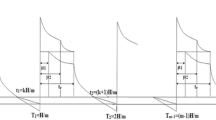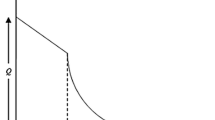Abstract
This study presents an economic production quantity (EPQ) model designed specifically for managing non-instantaneous linear deteriorating items characterized by linear time-dependent variable demands, linear time-dependent holding costs, and shortages with fully backlogged orders. The model considers the dynamic nature of item deterioration and demand patterns over time, providing a more realistic depiction of inventory systems. By incorporating fully backlogged orders, the model offers a nuanced approach to addressing shortages, contributing to a comprehensive understanding of inventory dynamics. The proposed EPQ model offers flexibility and adaptability to various scenarios, providing valuable insights for inventory management strategies. Through systematic analysis, the study aims to optimize the balance between total variable cost, ordering cost, holding cost, shortage cost, and deterioration costs, thereby enhancing operational efficiency and cost-effectiveness in inventory systems dealing with non-instantaneous linear deteriorating items and variable linear demands over time. The research findings have practical implications for industries handling Agricultural produce or time-sensitive goods, facilitating informed decision-making in inventory management.




Similar content being viewed by others
References
Harris, F.W.: How many parts to make at once. Factory Mag. Manag. 10(2), 135–136 (1913)
Misra, R.B.: Optimum production lot size model for a system with deteriorating inventory. Int. J. Prod. Res. 13(5), 495–505 (1975)
Sugapriya, C., Jeyaraman, K.: An epq model for non-instantaneous deteriorating item in which holding cost varies with time. Electron. J. Appl. Stat. Anal. 1(1), 16–23 (2008)
Manna, S., Lee, C., Chiang, C.: Eoq model for non-instantaneous deteriorating items with time-varying demand and partial backlogging. Int. J. Ind. Syst. Eng. 4(3), 241–254 (2009)
Tayal, S., Singh, S., Sharma, R., Singh, A.P.: An epq model for non-instantaneous deteriorating item with time dependent holding cost and exponential demand rate. Int. J. Oper. Res. 23(2), 145–162 (2015)
Ismail, M.T., Rahman, A.: Modelling, Simulation and Applications of Complex Systems, vol. 359, p. 20. Springer, Berlin (2021). https://doi.org/10.1007/978-981-16-2629-6
Malumfashi, M.L., Ismail, M.T., Bature, B., Sani, D., Ali, M.K.M.: An epq model for delayed deteriorating items with two-phase production period, variable demand rate and linear holding cost. Springer Proc. Math. Stat. 359, 351–380 (2021). https://doi.org/10.1007/978-981-16-2629-6-19
Malumfashi, M.L., Ismail, M.T., Rahman, A., Sani, D., Ali, M.K.M.: An epq model for delayed deteriorating items with variable production rate, two-phase demand rates and shortages. Springer Proc. Math. Stat. 359, 381–403 (2021). https://doi.org/10.1007/978-981-16-2629-6-20
Malumfashi, M.L., Ismail, M.T., Ali, M.K.M.: An epq model for delayed deteriorating items with two-phase production period, exponential demand rate and linear holding cost. Bull. Malay. Math. Sci. Soc. 45, 395–424 (2022). https://doi.org/10.1007/S40840-022-01316-X/FIGURES/8
Khan, M.A., Shaikh, A.A., Cárdenas-Barrón, L.E., Mashud, A.H.M., Treviño-Garza, G., Kosztyán, Z.T., Kovács, Z., Werner, F., Khan, A.-A., Shaikh, A.A., Cárdenas-Barrón, L.E., Hashan, A., Mashud, M., Treviño-Garza, G., Céspedes-Mota, A.: An inventory model for non-instantaneously deteriorating items with nonlinear stock-dependent demand, hybrid payment scheme and partially backlogged shortages. Mathematics 10, 434 (2022). https://doi.org/10.3390/MATH10030434
Sadeghi, H., Mahmoodi, A., Bashiri, B., Golbaghi, M.: An EPQ model for deteriorating products with delayed payments and shortage. J. Qual. Eng. Prod. Optim. (2022). https://doi.org/10.22070/JQEPO.2022.14964.1203
Rezagholifam, M., Sadjadi, S.J., Heydari, M., Karimi, M.: Optimal pricing and ordering strategy for non-instantaneous deteriorating items with price and stock sensitive demand and capacity constraint. Int. J. Syst. Sci. Oper. Logist. 9, 121–132 (2022). https://doi.org/10.1080/23302674.2020.1833259
Akhtar, M., Manna, A.K., Bhunia, A.K.: Optimization of a non-instantaneous deteriorating inventory problem with time and price dependent demand over finite time horizon via hybrid desgo algorithm. Expert Syst. Appl. 211, 118676 (2023). https://doi.org/10.1016/J.ESWA.2022.118676
Armbruster, C., Walzer, S., Witek, S., Ziegler, S., Farin-Glattacker, E.: Noise exposure among staff in intensive care units and the effects of unit-based noise management: a monocentric prospective longitudinal study. BMC Nurs. (2023). https://doi.org/10.1186/S12912-023-01611-3
Perez, F., Torres, F.: Inventory models for managing deteriorating products: a literature review (2020) Uniandes
Tripathi, R., Pareek, S., Kaur, M.: Inventory model with exponential time-dependent demand rate, variable deterioration, shortages and production cost. Int. J. Appl. Comput. Math. 3, 1407–1419 (2017). https://doi.org/10.1007/s40819-016-0185-4
Mohan, R.: Quadratic demand, variable holding cost with time dependent deterioration without shortages and salvage value. IOSR J. Math. 13(2), 59–66 (2017). https://doi.org/10.9790/5728-1302055966
Babangida, B., Baraya, Y.: An inventory model for non-instantaneous deteriorating items with time dependent quadratic demand, two storage facilities and shortages under trade credit policy. Int. J. Model. Oper. Manag. 8(1), 1–44 (2020)
Khanra, S., Chaudhuri, K.: A note on an order-level inventory model for a deteriorating item with time-dependent quadratic demand. Comput. Oper. Res. 30(12), 1901–1916 (2003)
Mishra, U.: An EOQ model with time dependent Weibull deterioration, quadratic demand and partial backlogging. Int. J. Appl. Comput. Math. 2, 545–563 (2016)
Viji, G., Karthikeyan, K.: An economic production quantity model for three levels of production with Weibull distribution deterioration and shortage. Ain Shams Eng. J. 9(4), 1481–1487 (2018). https://doi.org/10.1016/J.ASEJ.2016.10.006
Çalişkan, C.: An inventory ordering model for deteriorating items with compounding and backordering. Symmetry 13(6), 1078 (2021). https://doi.org/10.3390/SYM13061078
Alshanbari, H.M., El-Bagoury, A.A.A.H., Khan, M.A.A., Mondal, S., Shaikh, A.A., Rashid, A.: Economic order quantity model with weibull distributed deterioration under a mixed cash and prepayment scheme. Comput. Intell. Neurosci. 2021 Hindawi Limited (2021). https://doi.org/10.1155/2021/9588685
Sundararajan, R., Palanivel, M., Uthayakumar, R.: An EOQ model of non-instantaneous deteriorating items with price, time-dependent demand and backlogging. J. Control Decis. 8(2), 135–154 (2021). https://doi.org/10.1080/23307706.2019.1656560
Liao, J.J., Srivastava, H.M., Chung, K.J., Lee, S.F., Huang, K.N., Lin, S.D.: Inventory models for non-instantaneous deteriorating items with expiration dates and imperfect quality under hybrid payment policy in the three-level supply chain. Symmetry (2021). https://doi.org/10.3390/SYM13091695
Sharma, S., Tyagi, A., Verma, B.B., Garg, A.K., College, E., Kumar, S.: An inventory control model for deteriorating items under demand dependent production with time and stock dependent demand. Int. J. Oper. Quant. Manag. 27, 321–336 (2021). https://doi.org/10.46970/2021.27.4.2
Khan, M.A., Shaikh, A.A., Cárdenas-Barrón, L.E., Mashud, A.H.M., Treviño-Garza, G., Kosztyán, Z.T., Kovács, Z., Werner, F., Khan, A.-A., Shaikh, A.A., Cárdenas-Barrón, L.E., Hashan, A., Mashud, M., Treviño-Garza, G., Céspedes-Mota, A.: An inventory model for non-instantaneously deteriorating items with nonlinear stock-dependent demand, hybrid payment scheme and partially backlogged shortages. Mathematics 10(3), 434 (2022). https://doi.org/10.3390/MATH10030434
Khan, M.A.A., Ahmed, S., Babu, M.S., Sultana, N.: Optimal lot-size decision for deteriorating items with price-sensitive demand, linearly time-dependent holding cost under all-units discount environment. Int. J. Syst. Sci. Oper. Logist. 9(1), 61–74 (2022). https://doi.org/10.1080/23302674.2020.1815892
Chandramohan, J.: A multi-objective economic production quantity model for deteriorating items with impact of the pandemic, social and environmental concerns. J. Ind. Prod. Eng. 40(5), 375–396 (2023). https://doi.org/10.1080/21681015.2023.2207848
Khan, A., Shaikh, A., Panda, C., Konstantaras, I., Taleizadeh, A.: Inventory system with expiration YEAR: pricing and replenishment decisions. Comput. Ind. Eng. 132, 232–247 (2019). https://doi.org/10.1016/J.CIE.2019.04.002
Acknowledgements
The authors sincerely thank the reviewers for their insightful comments and constructive suggestions, which significantly contributed to the enhancement of this manuscript.
Author information
Authors and Affiliations
Corresponding author
Ethics declarations
Conflict of interest
The authors declare that they have no conflict of interest to disclose.
Additional information
Publisher's Note
Springer Nature remains neutral with regard to jurisdictional claims in published maps and institutional affiliations.
Rights and permissions
Springer Nature or its licensor (e.g. a society or other partner) holds exclusive rights to this article under a publishing agreement with the author(s) or other rightsholder(s); author self-archiving of the accepted manuscript version of this article is solely governed by the terms of such publishing agreement and applicable law.
About this article
Cite this article
Rabiu, S., Ali, M.K.M. Optimizing inventory dynamics: a smart approach for non-instantaneous deteriorating items with linear time function dependent variable demands and holding costs, shortages with backlogging. J. Appl. Math. Comput. (2024). https://doi.org/10.1007/s12190-024-02089-1
Received:
Revised:
Accepted:
Published:
DOI: https://doi.org/10.1007/s12190-024-02089-1
Keywords
- Linear time function
- Variable demands
- Linear holding cost
- Non-instantaneous
- Exponential time function
- Deteriorating items




